
October, 1961
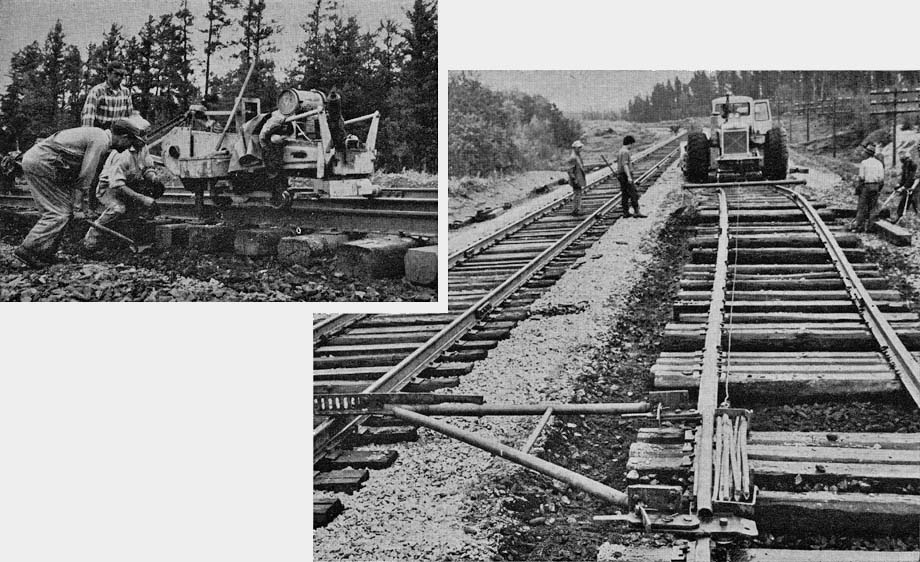
RIGHT - A double track liner is seen here restoring the approximate line of track as a toboggan sled and men remove worn ties. Freshly laid ballast makes sharp contrast to old roadbed, saturated with years of ash and cinders.
It may not be a world record, but could be pretty close to one, prairie region officials think as they study details of this summer's track ballasting program.
Maintenance crews are nearing the end of the 1961 program renewing ballast on 300 miles of main track on the Kenora, Moose Jaw, Regina, and Brandon divisions at an estimated cost of $1,300,000.
Taking the Kenora division as an example, labour cost for carrying out ballasting this year has been
approximately one-third of the cost 11 years ago before present methods were adopted.
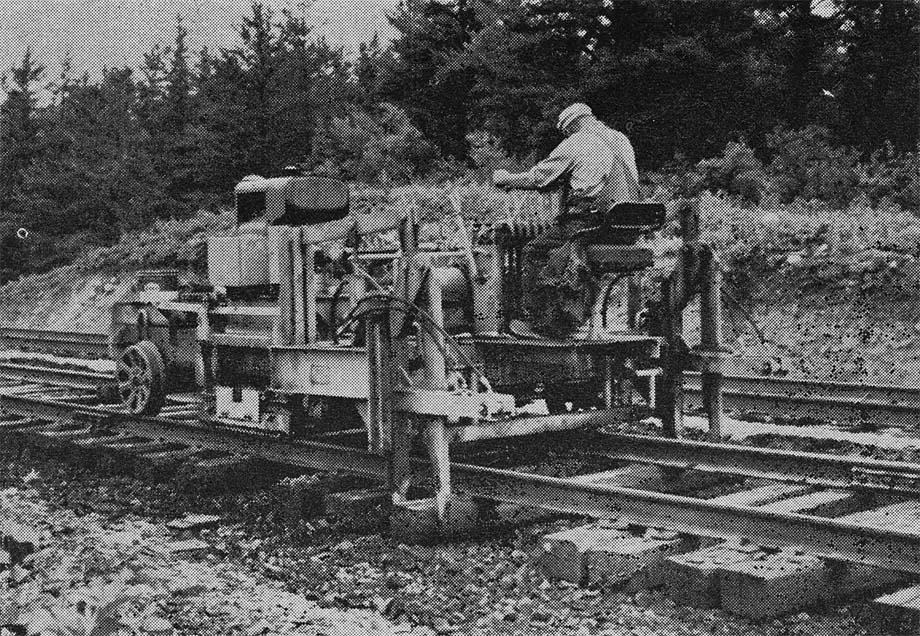
Average miles per day completed this year was at last record 2.03 compared with less than one mile per
day eight years ago.
The secret for success has been greater use of modern machines, and even more important, teamwork from the original planning in the office of K.A. Truman, regional engineer, until final trim is completed at the scene of operation by a few men using hand tools.
While this article and the accompanying photographs deal primarily with work done on the Kenora division, the same system applied to all jobs of this nature completed this year.
Passengers will not see the improvements in the roadbed from which the old ballast was removed, ballast
which, in the past 25 years, had been saturated with about six inches of fly ash and coal cinders deposited by
steam locomotives. But the new carpet will give them a smoother ride, reduce wear and tear on the equipment
that is geared to roll the country's commerce across the nation, and also prolong the life of the
tracks.
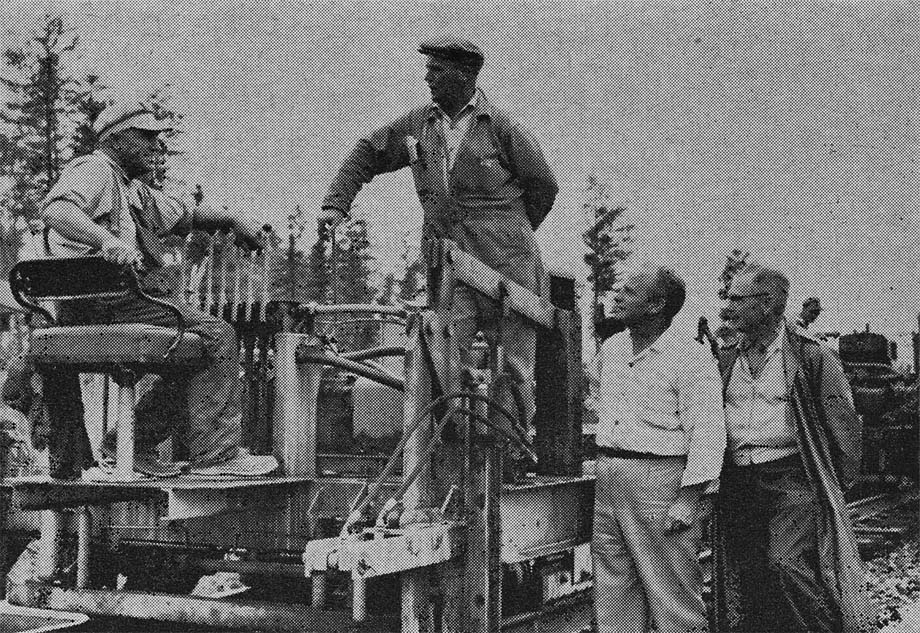
The new magic carpet under the rails is the new crushed rock ballast which is being applied to a depth of
five inches at a rate of 1,900 cubic yards per mile.
The ballast, besides forming a solid base for the roadbed, is also essential for drainage purposes. It will
in time outlive its usefulness when the water can no longer run off, and together with a mixture of dust and
dirt mixed in by the elements, will settle like mud on the bottom and eventually harden like cement. This
condition is not only hard on the fast-moving equipment but also gives the customer an uncomfortable
ride.
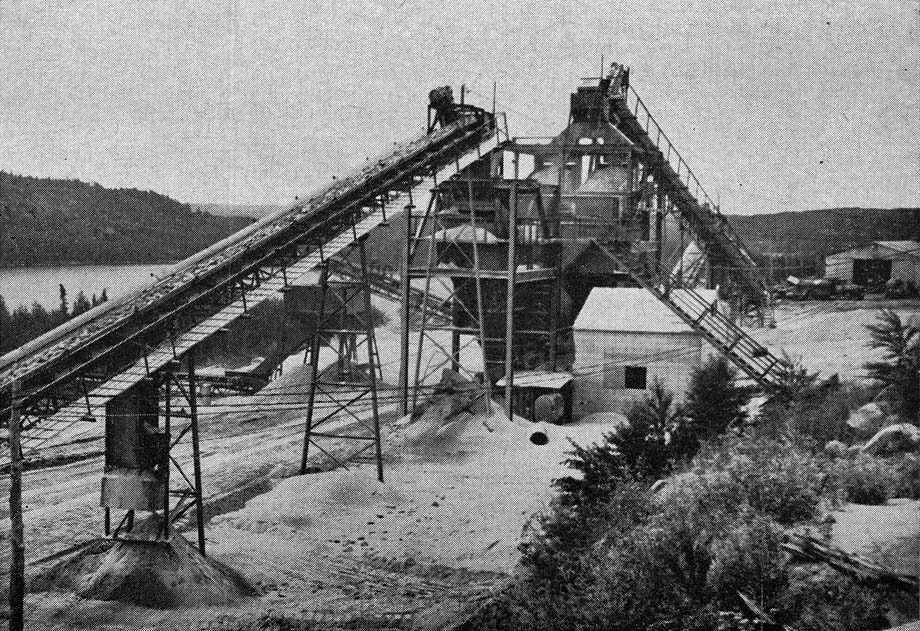
Here is a general picture of how the whole operation is smoothly synchronized to get maximum usage and
performance from both men and machines.
The track is first lifted by means of jacks for a length of about 12 feet and a machine known as a toboggan bottom ballast sled is pushed under the rails and ties by a tractor. Then the jacks are removed.
The rubber tired tractor is positioned about 50 feet in front of the sled, linked by steel towing cables,
after which the sled proceeds to plow under the old ballast at a comfortable walking speed. Stops are made at
infrequent intervals to enable the track crew following to remove bad ties which are no longer fit for
service.
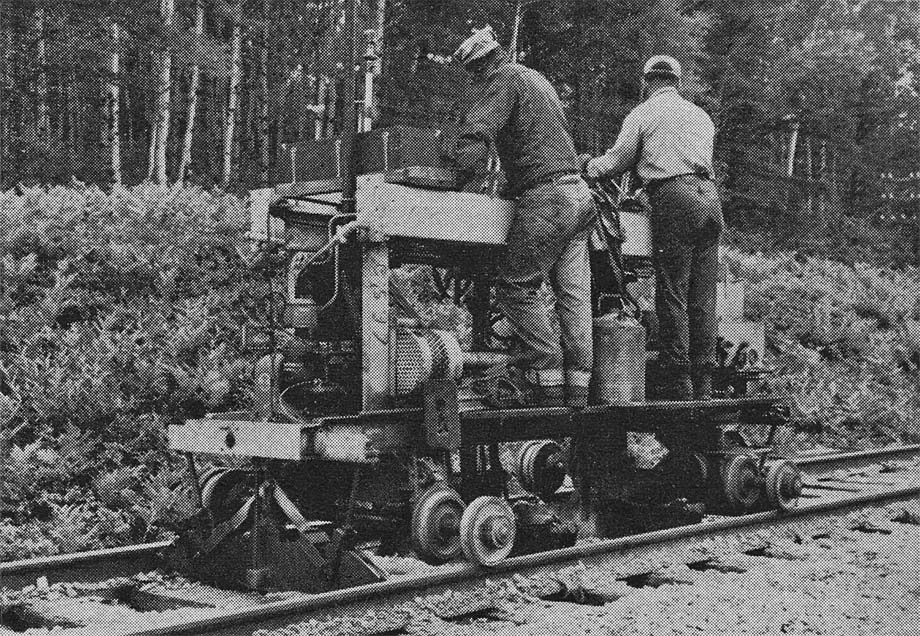
When working in double track a lining device is attached to the sled and to the adjacent track. This device
keeps track being worked in reasonably good line.
Following the sledding operation, ties are properly spaced by means of two Pullman tie spacing machines. These machines do the work which was formerly done by about 25 men. Following the tie-spacers a further portion of the gang replaces ties which have been removed from the track, as well as installing additional ties which are required to bring the number of ties up to present C.P.R. standard. This portion of the operation is largely hand work except for the driving of spikes which is done with mechanical spike hammers.
After tie renewals have been completed the gang distributes new crushed rock ballast from longitudinal
hopper cars at the prescribed rate per mile. Two miles of rock involving approximately 70 cars and weighing
about 5,600 tons are unloaded and spread with a Jordan spreader in an average of an hour and a
half.
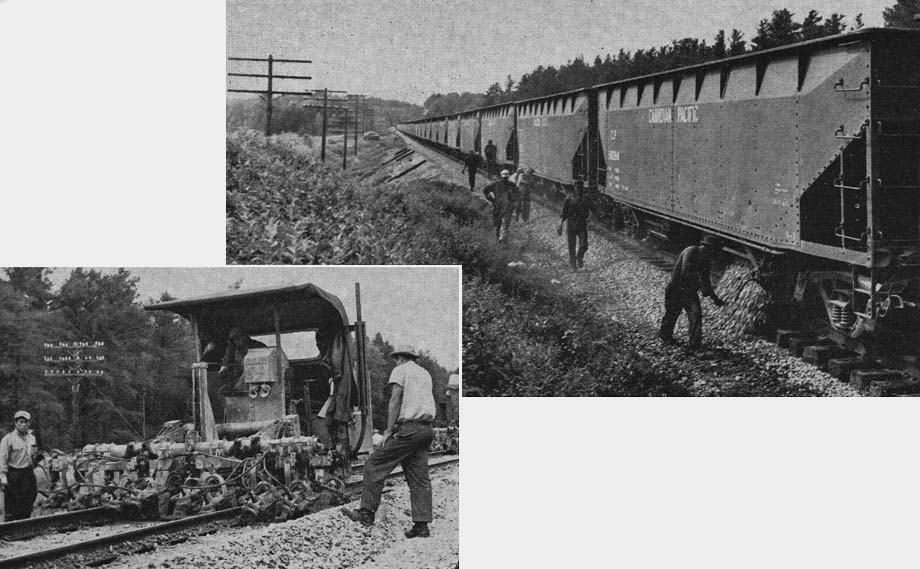
RIGHT - The unloading gang is seen at work along a ballast train. Some 5,600 tons of new ballast are unloaded by approximately 70 cars along two miles of track. Speed of the train is governed while ballast is being unloaded, putting fresh stone where needed.
The No. 1 or "front-end gang" works approximately two miles ahead of the No. 2 or "rear
gang." After new ballast has been distributed on the track, the No. 2 gang then proceeds to lift, surface,
line, and trim the track. The first part of this operation involves lifting the track by means of a power track
jack and Nordberg wire surfacing device to the correct elevation.
The surplus ballast which has remained on top of the ties is then removed by a mechanical track broom.
This operation is followed by three vibratory multiple tamping machines each of which tamps solidly every
third tie. Working together these three machines are capable of tamping slightly more than three miles of track
in a day.
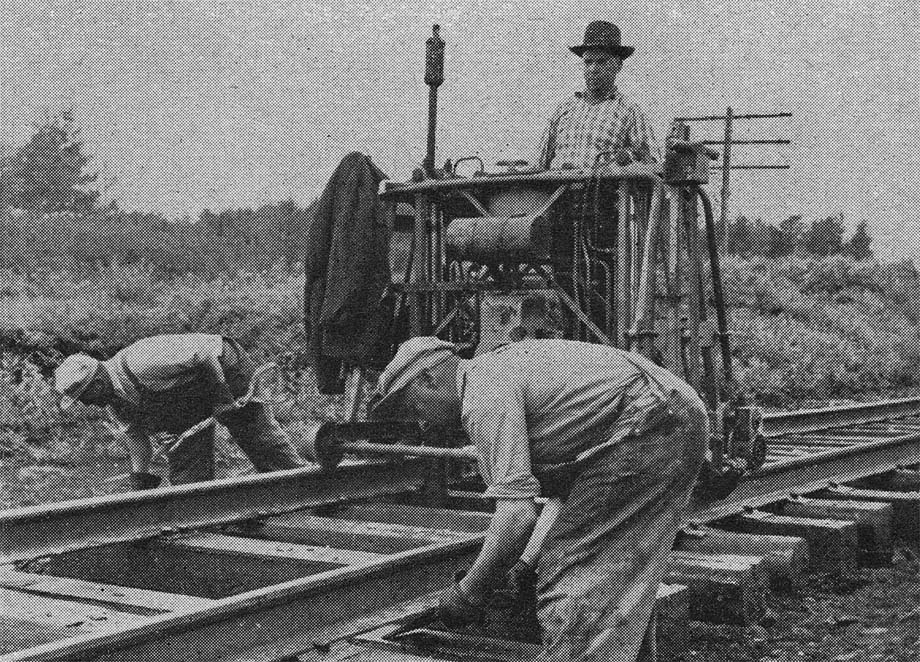
Following the tampers, the track is brought to final line by a two-point mechanical track liner. This machine
is operated by one man with a helper and the sighting for lining is done by one man using a telescope similar to
that used in a surveyor's transit.
After the lining operation is effected the ballast is trimmed and regulated by a ballast regulating machine, and the final trim is made by a few men with hand tools.
The ballasting gangs work an average of 10 hours per day and during this season have averaged slightly more
than two miles of track, completed, per day.
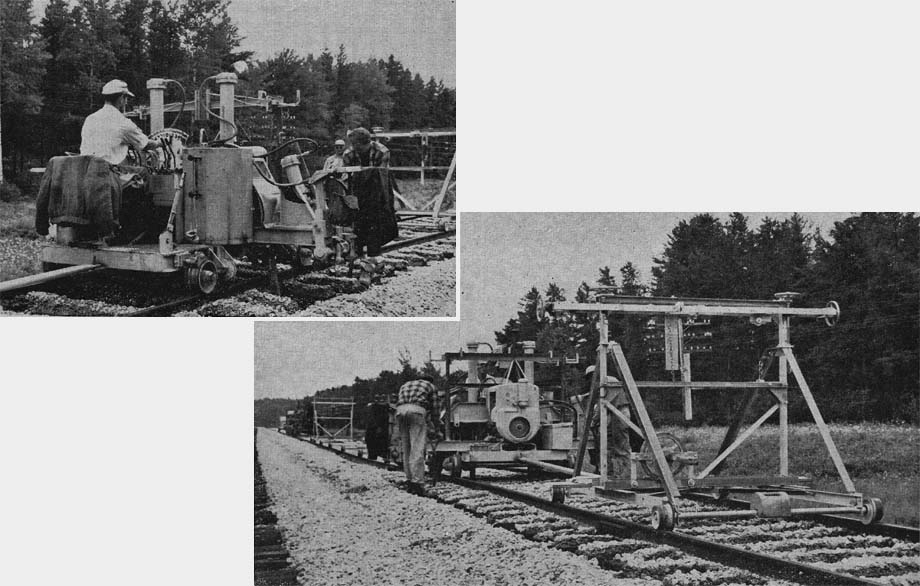
RIGHT - With its pint-sized flanged wheels and gangly superstructure, the Kershaw Jackall tamping jack presents an unusual sight as it proceeds along the rails.
Lunch is brought out to the working point and the men eat where they finish work at lunch time. In
double-track territory, the track on which work is in progress is taken out of service during the working day
and is restored to service during night time with an appropriate slow order being in effect.
This efficient new system did not develop overnight. First real progress was made about eight years ago under
the direction of G. James Yorston, then supervisor of maintenance of way, now in the same position in the
Pacific region.
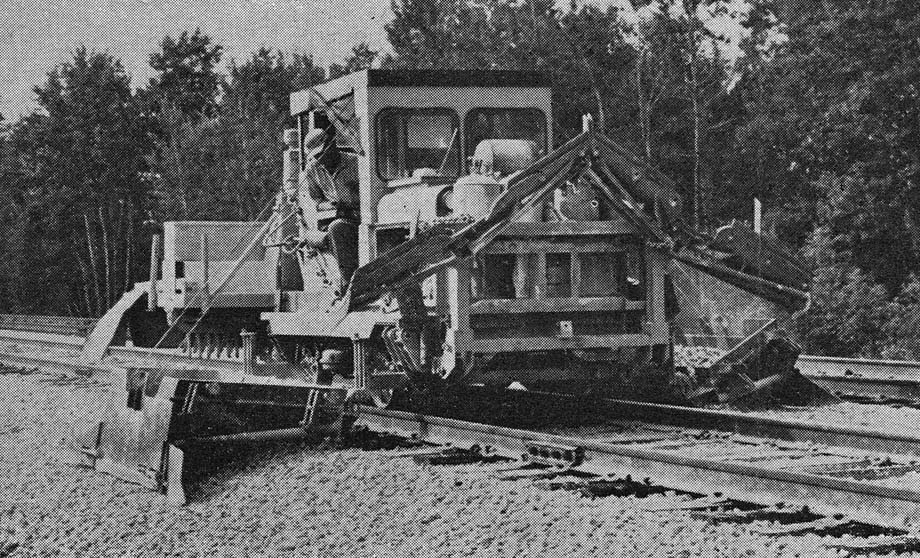
Charles King, supervisor of maintenance of way in the prairie region, a man with considerable practical
experience on track gangs, has carried on and improved on the innovations of eight years ago.
C.K. Holden, assistant regional engineer, handles much of the organizing of equipment and materials before any job is started.
Garnet B. Beach, assistant engineer, sees that the machines are always in good repair. Gunnar Anderson, of Kenora, under the direct supervision of divion engineer Stan Cook, is roadmaster in charge of ballasting in the eastern part of the region, the man constantly on the scene to co-ordinate operations on a minute-by-minute basis.
In addition to the above personnel, the superintendent, his division engineer, dispatching staffs, and regular roadmasters on whose territory ballasting programs are carried out, deserve a lot of credit for looking after the many details involved in this work and keeping the trains rolling, although some of their trackage was under repair.
The labouring force is not a pick-up crew but men who return to the job each year, each a specialist in his own job.
Excellent teamwork, special machines constantly maintained in good repair, and intelligent workmen are the recipe for the track-ballasting record being set in the prairie region.
 and is reprinted here with their permission. All photographs,
logos, and trademarks are the property of the Canadian Pacific Railway
Company.
and is reprinted here with their permission. All photographs,
logos, and trademarks are the property of the Canadian Pacific Railway
Company.